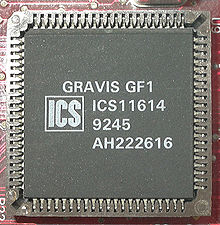Gravis Ultrasound
Gravis Ultrasound or GUS is a sound card from Advanced Gravis for the IBM-compatible PC . It was quite widespread in the tracker and demo scene in the 1990s , as it was superior to other, similarly expensive sound cards of the time in terms of sound quality. It was able to play samples on several channels at the same time without having to use the CPU of the computer for mixing. This made complex pieces of music and sound effects possible with minimal use of the computer.
In contrast to most PC expansion cards of their time, the majority of the model range was made from circuit boards with red solder mask . Only a few models, such as B. the license replica AltraSound , were made of green colored circuit boards.
Technical
The sound card, released in 1991, had its own RAM (maximum 1 MB), its own mix chip (Gravis GF1, a license copy of the ICS11614) and was connected to the ISA slot. The internal sound mixer relieved the CPU and enabled the mixing of up to 32 voices at 16-bit resolution. The resampling required for this , the task of a sampler in the audio sector , was carried out by the GF1 using value interpolation. The achievable sampling rate was directly dependent on the number of voices used. Up to 14 voices could be mixed at 44.1 kHz, these playback frequencies were then reduced with each additional voice so that with 32 voices this was only 16 kHz. The GF1 did not contain an effect part.
The Interwave sound controller produced by AMD formed the basis of the Gravis Ultrasound PnP released in 1995. This sound controller could be switched to a GF1 compatible mode. In addition, this sound controller supported up to 8 MB RAM in interwave mode and had an effects processor that supported effects such as reverb, echo, chorus, flanging and fading.
compatibility
The greatest handicap of the Ultrasound series was its lack of game compatibility. The sound output of the computer games , which at that time mostly ran under MS-DOS , was mostly designed for Sound Blaster sound cards only. With the Soundblaster emulation driver ( SBOS , MegaEm ) offered by Gravis , it was possible for some games to output sound effects and music on ultrasound cards. The cooperation often only harmonized smoothly with games that offered direct CIS support. For a long time these were few and far between.
The sound card could also be used under OS / 2 , which, however, was not very successful in the home user sector. Office PCs were mostly operated without a sound card at that time.
The insufficient compatibility with the newer Windows versions was ultimately the main reason why the card was gradually ousted by Creative. There were drivers for these operating systems, but they were very difficult to configure and never got beyond the beta stage.
Model series
The CIS appeared in different versions. There was the “Gravis Ultrasound” (with 512 kB memory; also “Gravis Ultrasound Classic” to distinguish it from other models), the “Gravis Ultrasound Max” (with 512 kB of its own memory, expandable by a further 512 kB). "Gravis Ultrasound Plug & Play" ( GUS PNP ) was later published in cooperation with processor manufacturer AMD . This card could be upgraded with 30-pin SIMM- RAM to a maximum of 8 MB of its own memory. Hobbyists found a way to solder two more SIMM slots and thus double the memory again.
With the license replica "AltraSound" it was possible to upgrade the card, which was equipped with 512 KB in the delivery state, with a further 512 KB.
End of the product line
On November 21, 1997 Gravis discontinued the Ultrasound product line.
Web links
- UltraSound PC Sound Cards. ( Memento from February 20, 1997 in the Internet Archive ) Product page of the manufacturer Gravis (English)
- Eric Wing: The History of PC Game MIDI (English)
- Stefan Göhler: ... a look back at the sound card history of Crossfire Designs (2004)
- Eric A. Welsh: FreePats ( Memento from December 13, 2004 in the Internet Archive ) - Collection of CIS-compatible patches (English)
- My Gravis Ultrasound Resource Guide ( Memento from June 1, 2007 in the Internet Archive ) Collection of CIS-related resources, January 2000 (English)
- TiMidity ++ - A software synthesizer with GUS support
- GUS Emulator (English) accessed January 2012
Individual evidence
- ↑ Stefan Göhler: 1991 - competition! - (Advanced) Gravis Ultrasound . In: Phonomenal! . crossfire-designs.de. P. 9. Retrieved January 21, 2012.
- ↑ Advanced Gravis Announced Today That It Has Discontinued Its Sound Card Business ( English ) Gravis . November 21, 1997. Archived from the original on February 20, 1998. Retrieved January 24, 2012.


